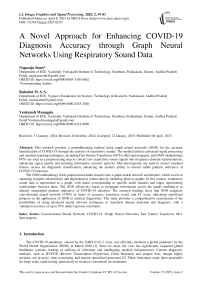A Novel Approach for Enhancing COVID-19 Diagnosis Accuracy through Graph Neural Networks Using Respiratory Sound Data
Автор: Nagaraju Sonti, Rukmini M.S.S., Venkatesh Munagala
Журнал: International Journal of Image, Graphics and Signal Processing @ijigsp
Статья в выпуске: 2 vol.17, 2025 года.
Бесплатный доступ
This research presents a groundbreaking method using graph neural networks (GNN) for the accurate identification of COVID-19 through the analysis of respiratory sounds. The method utilizes advanced signal processing and machine learning techniques, including Fast Fourier Transforms (FFTs), Mel-spectrograms, and GNN methodology. FFTs are used as a preprocessing step to convert raw respiratory sound signals into frequency-domain representations, enhancing signal quality and isolating informative acoustic patterns. Mel-spectrograms are used to extract essential feature vectors for diagnostic classification, enhancing the model's ability to discern subtle patterns indicative of COVID-19 infection. The GNN methodology feeds preprocessed audio features into a graph neural network architecture, which excels at capturing complex relationships and dependencies within data by modeling them as graphs. In this context, respiratory sound data is represented as a graph, with nodes corresponding to specific audio features and edges representing relationships between them. The GNN effectively learns to propagate information across the graph, enabling it to identify meaningful patterns indicative of COVID-19 infection. The research findings show that GNN surpasses convolutional neural network (CNN) in terms of accuracy, precision, recall, and F1 score, indicating significant progress in the application of GNN in medical diagnostics. The study provides a comprehensive examination of the possibilities of using advanced neural network techniques to transform disease detection and diagnosis, with a validation accuracy of up to 97% under rigorous constraints.
Convolutional Neural Network, COVID-19, Graph Neural Networks, Fast Fourier Transform, Mel-Spectrogram
Короткий адрес: https://sciup.org/15019715
IDR: 15019715 | DOI: 10.5815/ijigsp.2025.02.03


